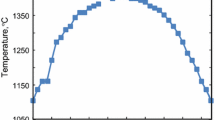Abstract
The texture, distribution, and infiltration tendency of a quartz-albite melt in equilibrium with a synthetic, texturally-equilibrated quartzite was examined in a series of distribution and infiltration experiments at 1,250° C and 8 kbar hydrostatic pressure. Wetting angle measurements from melt distribution experiments show a dihedral angle (θ) of 60 degrees, implying a quartz/quartz interfacial energy approximately 1.7 times the quartz/melt value. Because of this specific relationship between interfacial energies, the system can achieve its lowest surface free energy state with the melt either in pools or along grain edge intersections, possibly forming some interconnected channels. Stability of melt in pockets and along grain edge intersections was observed in a fourteen-day, dispersed-melt experiment, yet melt pools failed to disperse into the quartzite during infiltration experiments. Comparison of the observed dihedral angle with previously measured surface energy values for the melt and quartz shows excellent agreement, and also demonstrates that an aggregate of randomly orientated anisotropic grains acts approximately isotropically.
While these experiments are not strictly applicable to real crustal systems, they do indicate that, at least in some felsic systems, the melt has no preference for uniform grainedge wetting relative to collection at grain corners or in large pools. This “ambivalent” behavior is attributable to the 60-degree wetting angle, which has been shown to separate systems in which melt tends to disperse in interconnected channels (θ<60°) from those in which melt tends to become isolated at grain corners (θ> 60°).
Similar content being viewed by others
References
Brace WF, Walsh JB (1962) Some direct measurements of the surface energy of quartz and orthoclase. Am Mineral 47:1111–1122
Bulau JR, Waff HS, Tyburczy JA (1979) Mechanical and thermodynamic constraints of fluid distribution in partial melts. J Geophys Res 84:6102–6108
Cooper RF, Kohlsdedt DL (1982) Interfacial energies in the olivine basalt system. In: Akimoto S, Manghnani MH (eds), High pressure research in geophysics. Center for Academic Publications, Tokyo pp 217–228
Dunn CG, Lionetti F (1949) The effect of orientation difference on grain boundary energies. Trans AIME 185:125–132
Hondros ED, McLean D (1976) Grain boundary fragility. In: Chadwick GA, Smith DA (eds) Grain boundary structure and properties, Academic Press, London New York San Francisco, pp 357–359
Kingery WD, Bowen HK, Ulhmann DR (1976) Introduction to ceramics. Wiley and Sons, New York, pp 177–216
Martin H (1979) Geochemical behavior of major and trace elements during incongruent melting of biotite in the St. Malo massif migmatites. N Jahrb Mineral Monatsh 11:509–524
Mehnert KR, Busch W, Schneider G (1973) Initial melting at grain boundaries of quartz and feldspar in gneisses and granulites. N Jahrb Mineral Monatsh 4:165–183
Moment RL, Gordon RB (1964) Energy of grain boundaries in halite. J Am Ceram Soc 47:570–573
Nesbitt HW (1980) Genesis of the New Quebec and Adirondack granulites: evidence for their production by partial melting. Contrib Mineral Petrol 72:303–310
Price RC, Taylor SR (1977) The rare earth geochemistry of granite, gneiss, and migmatite from the western metamorphic belt of Southeastern Australia. Contrib Mineral Petrol 62:249–263
Rapela CW, Shaw DM (1979) Trace and major element models of granitiod gneisses in the Pampean Ranges, Argentina. Geochim Cosmochim Acta 43:1117–1129
Readey DW, Jech RE (1968) Energies and grooving kinetics of [001] tilt boundaries in nickel oxide. J Am Ceram Soc 51:201–208
Riegger OK, Van Vlack LH (1960) Dihedral angle measurement. Trans AIME 218:933–935
Smith CS (1964) Some elementary principles of polycrystalline microstructure. Metall Rev 9:1–48
Waff HS, Bulau JR (1979) Equilibrium fluid distribution in an ultramafic partial melt under hydrostatic stress conditions. J Geophys Res 84:6109–6114
Waff HS, Bulau JR (1982) Experimental determination of near equilibrium textures in partially molten silicates. In: Akimoto S, Manghnani MH (eds), High pressure research in geophysics. Center for Academic Publications, Tokyo pp 229–236
Walker D, Mullins O (1981) Surface tension of natural silicate melts from 1,200°–1,500° C and implications for melt structure. Contrib Mineral Petrol 76:455–462
Watson EB (1982) Melt infiltration and magma evolution. Geology 10:236–240
White AJR, Chappell BW (1977) Ultrametamorphism and granitiod gniesses. Tectonophys 43:7–22
Winkler HGF, Breitbart R (1978) New aspects of granitic magmas. N Jahrb Mineral Monatsh 10:463–480
Author information
Authors and Affiliations
Rights and permissions
About this article
Cite this article
Jurewicz, S.R., Watson, E.B. Distribution of partial melt in a felsic system: the importance of surface energy. Contr. Mineral. and Petrol. 85, 25–29 (1984). https://doi.org/10.1007/BF00380218
Received:
Accepted:
Issue Date:
DOI: https://doi.org/10.1007/BF00380218




